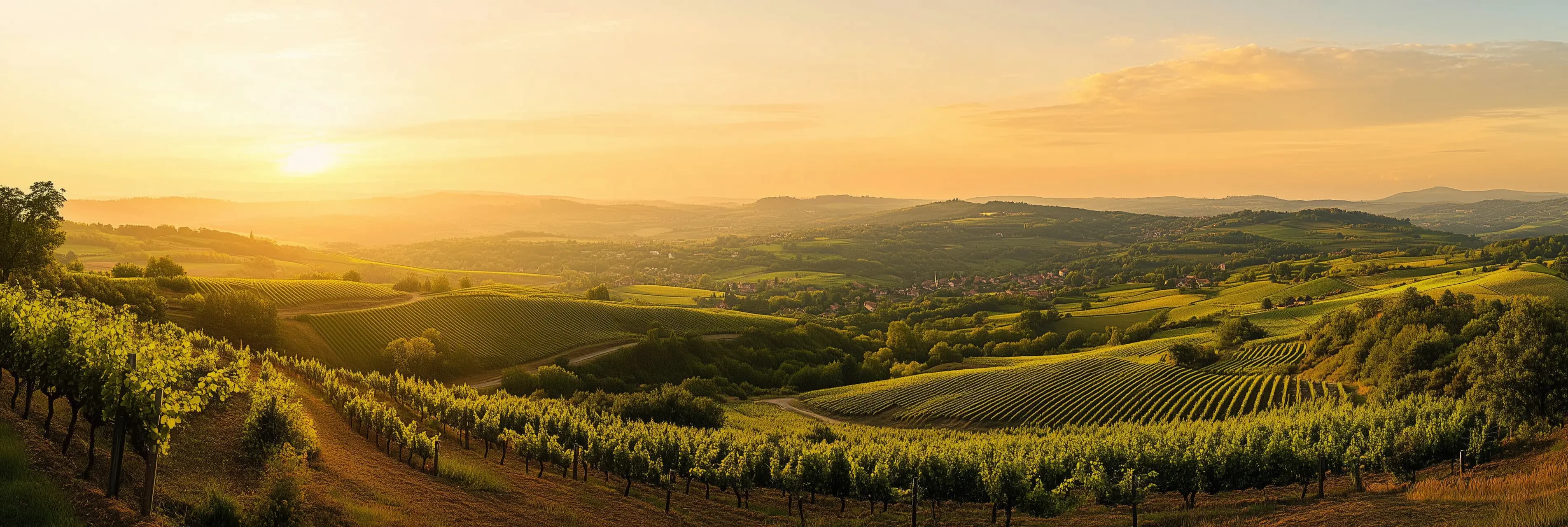38 shades of terroir
When we talk about Beaujolais Villages, we're referring to wines that come from 38 designated villages in the northern part of the Beaujolais region. These villages are known for producing wines with more complexity and structure than their southern counterparts. But what exactly makes these 38 villages special, and how do they contribute to the character of Beaujolais Villages wines? Let’s take a journey through this diverse region and explore what sets it apart.
The 38 villages of Beaujolais Villages AOC
The northern Beaujolais region, with its rolling hills and granite-based soils, is home to these 38 villages. While they all contribute to the richness and diversity of Beaujolais Villages wines, some stand out for their reputation and wine quality.
Here is the full list of villages that form the backbone of this appellation:
- Lantignié
- Quincié-en-Beaujolais
- Vaux-en-Beaujolais
- Salles-Arbuissonnas-en-Beaujolais
- Régnié-Durette
- Saint-Étienne-la-Varenne
- Saint-Julien
- Saint-Lager
- Odenas
- Le Perréon
- Cercié
- Chiroubles (partly within the Cru Chiroubles)
- Charentay
- Émeringes
- Fleurie (mostly within the Cru Fleurie)
- Juliénas (mostly within the Cru Juliénas)
- Chénas (partly within the Cru Chénas)
- Lancié
- Chiroubles (shared with the Chiroubles Cru)
- Villié-Morgon (also within the Morgon Cru)
- Montmerle-sur-Saône
- Saint-Didier-sur-Beaujeu
- Saint-Jean-d'Ardières
- Beaujeu (historical capital of Beaujolais)
- Les Ardillats
- Ouroux
- Monsols
- Avenas
- Vernay
- Trades
- Marchampt
- Chénelette
- Propières
- Saint-Igny-de-Vers
- Saint-Mamert
- Chambost-Allières
- Pouilly-le-Monial
- Theizé
These villages are spread across the northern part of Beaujolais, where the soil and climate are particularly well-suited for the Gamay grape. While not all of these villages are as famous as the Crus, they each contribute their own unique characteristics to the wines labeled as Beaujolais Villages.
Why these villages matter?
The key to understanding the importance of these 38 villages lies in their terroir. The northern part of Beaujolais is dominated by granite, schist, and volcanic soils, which are ideal for producing more complex and structured wines. Compared to the flatter, more fertile lands of southern Beaujolais, the vineyards here are on hillier terrain, often at higher altitudes.
This slower ripening of grapes results in wines with:
- Higher acidity, which adds freshness and longevity.
- Greater minerality, often found in wines with granite soils.
- More complex flavor profiles, ranging from ripe red fruits to earthy, spicy notes.
Highlighting a few key villages
While all 38 villages contribute to the Beaujolais Villages AOC, a few are particularly renowned for their high-quality wines:
- Lantignié: Known for producing some of the finest Beaujolais Villages wines, with exceptional balance and a touch of elegance often compared to the Crus.
- Quincié-en-Beaujolais: A village that consistently delivers expressive, fruit-forward wines with great depth.
- Régnié-Durette: Bordering the Cru Régnié, this village is known for wines that exhibit freshness and bright fruit flavors.
- Saint-Lager: Produces wines with a strong sense of minerality, typical of the northern Beaujolais region.
The impact of terroir on Beaujolais Villages
What sets the wines from these villages apart from the broader Beaujolais AOC? It comes down to terroir. The influence of granite soils and the cooler climate of the north give Beaujolais Villages wines more structure, acidity, and complexity compared to their southern counterparts. This also means they can age longer, sometimes up to five years, allowing the wine to develop more layers of flavor.
Tasting Beaujolais Villages
Wines from the Beaujolais Villages AOC are a great introduction to the diversity of the Beaujolais region.
Here’s what you can typically expect in a glass of Beaujolais Villages:
- Color: Bright ruby red, sometimes with deeper purple tones.
- Aromas: Expect a bouquet of red berries—strawberries, raspberries, cherries—with floral and earthy undertones.
- Taste: Fresh and lively, with well-balanced acidity. The red fruit flavors are often complemented by spice, herbs, and a subtle mineral finish.
- Body: Light to medium-bodied, with softer tannins than the Beaujolais Crus, but more structure than Beaujolais AOC.
The 38 villages of Beaujolais Villages are the unsung heroes of the northern Beaujolais region. With their unique terroir, they provide a step up in quality from the broader Beaujolais AOC, offering wines that are more complex, age-worthy, and versatile. Whether you're exploring Beaujolais for the first time or looking to deepen your knowledge, these villages are worth discovering for their rich contribution to one of France’s most dynamic wine regions.

